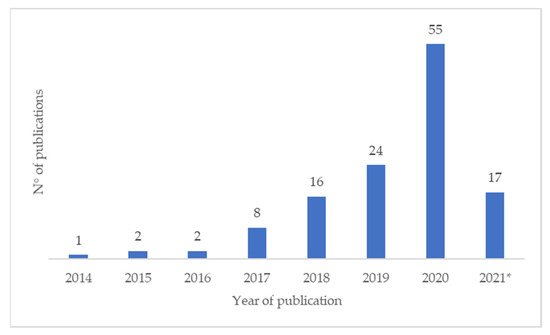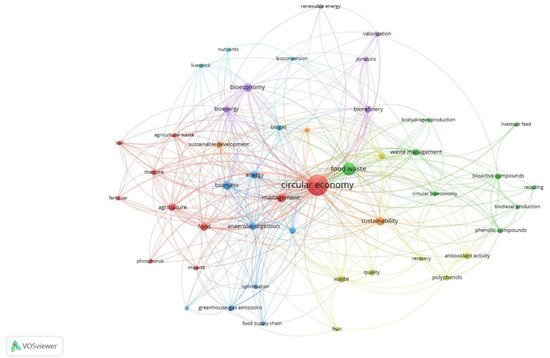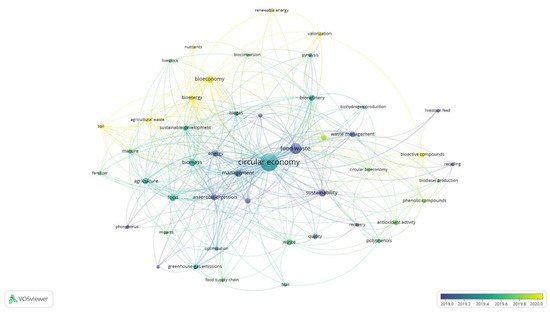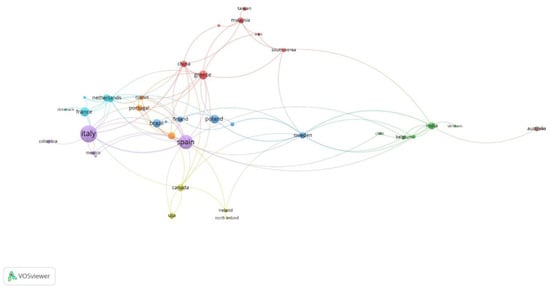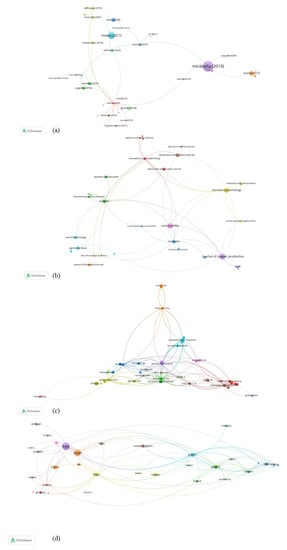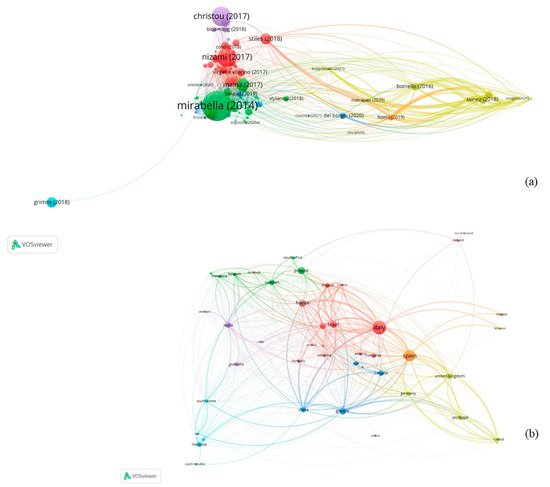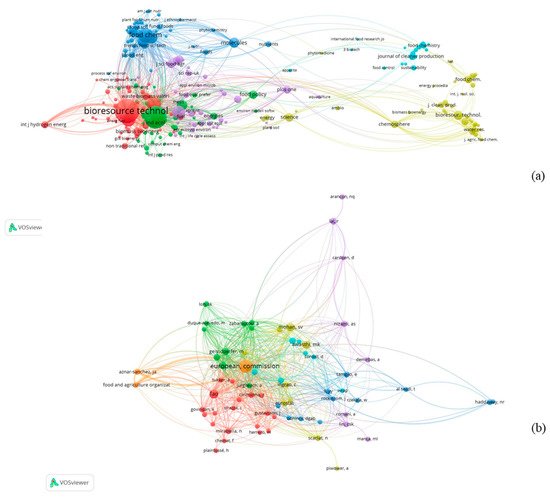The current agri-food supply chain is affected by different problems of economic, social and environmental natures, making it unsustainable. Among the possible solutions, the circular economy offers tools to enhance and optimize the production and consumption to seek to a sustainable paradigm [1]. Over the last decade, growing attention has been paid to this new concept with the aim to provide an alternative to the dominant linear economic model [2,3]. Indeed, the circular economy is a model of production and consumption that involves sharing, leasing, reusing, repairing, refurbishing and recycling existing materials and products as long as possible, extending the life cycle of products and reducing waste to a minimum [4]. The circular economy concept is of great interest as a way to implement the sustainable development [5]. It is a concept currently promoted by the European Union [6,7] to enhance competitiveness, protecting businesses against scarceness of resources and helping to create new opportunities and innovative markets [8].
The distribution of papers over the years, the most active countries, the journals most involved, the areas in which the research is currently focused and the most important papers are shown in this section.
Based on the literature review, it is possible to underline the fact that the circular economy is a concept of marked interest. This is proven by the fact that the initial research with less constrictions gave a total result of 1557 publications in Scopus and WoS, and it is experiencing a positive trend in publications, with an exponential increase of the documents in recent years. Despite this fact, the tie with the agricultural and agri-food sector is still not fully exploited. This result can also be deduced from the research areas investigated: there is a tendency to focus still on the environment and engineering (bioenergy, in particular), rather than economics (with the development of models designed to evaluate the feasibility and circularity of a production system) and agriculture. Circular economy represents a novel economic model, where the old linear “make-use-dispose” wants to be replaced by a circular approach based on the “3R” principles “reduction-reuse-recycling”. It is notable that the publications regarding policy and economics are few, as are the ones related to the consumer and their approach to the reuse and valorisation of wastes in food products.
From the literature and bibliometric analysis, Europe resulted as the most active in the research. However, circular economy only recently has become prominent among the European policy makers [
53], drawing from the publication of the Circular Economy Action Plan in 2015 and the New Circular Economy Action Plan in 2020. In particular, Italy, Spain and The United Kingdom are the countries with the highest number of publications (by themselves, they represent the 36% of the total amount of documents). This result is in line with the recent political actions of the European Union in terms of green economy and ecological transition: the aim is to reach climate neutrality by 2050 [
54] and reduce wastes up to 20% by 2030 [
55]. Moreover, the farm-to-fork strategy is at the heart of the European Green Deal [
56]. It addresses the challenges of sustainable food systems and reinforces the links between people and the environment. The strategy is also in line with the Commission’s agenda to achieve the United Nations’ Sustainable Development Goals (SDGs), in particular SDG 12 (Responsible Consumption and Production) [
57].
A shift to a sustainable food system can bring environmental, health and social benefits. The link among the farm to fork strategy and the Circular Economy Action Plan is evident, as the European Commission takes action to promote sustainable production methods and circular business models in the agri-food sector. The transition to a circular and sustainable EU green economy provides business opportunities, for instance linked to making use of food waste [
58]. To support these new strategies, the European Commission and the European Economic and Social Committee set up the European Circular Economy Stakeholder Platform (ECESP). ECESP is a joint initiative born to foster the transition towards a circular economy, bringing together stakeholders that are active in the field of the circular economy, following the actions included in the 2015 Circular Economy Action Plan [
59].
In addition to the European policies, each Member State has a different approach to the circular economy, and it is not possible to find a common regulation followed by all. There is a great discrepancy as some have been implanting a circular model for several years, while others are only approaching it recently following the European example. The Netherlands is one of the most virtuous countries. The government aims to implement a circular model by 2050, and the ambition is to realise a 50% reduction in the use of primary raw materials by 2030 [
60]. France put in place the Energy Transition Law for Green Growth project in 2015 and an ambitious roadmap for a circular economy in 2018. Recently, in February 2020, the so-called Anti-Waste Law for a Circular Economy promoted the management and prevention of waste production, the improvement of consumer information, the fight against squandering and the reuse of resources. This French act of law contains about 50 measures regarding obligations for the creation of producer responsibility, prohibitions on single-use plastics and to fight waste of food and non-food unsold products, new tools to better control and sanctions [
61]. Italy is in the top positions in Europe in terms of the circular economy [
62]. There is work in progress in the policies and regulations approved at national level. As a consequence of the issuance of the Law n. 221 of 28 December 2015, the so-called "Collegato Ambientale" and of other regulatory measures, the Italian government has put in place some actions aimed at promoting the circular economy (Decreto Ministeriale del 24 maggio 2016; Decreto Ministeriale del 26 maggio 2016; Decreto Ministeriale del 10 giugno 2016, n.140; Legge n. 166 del 19 agosto 2016; Decreto Ministeriale n.264 del 13 ottobre 2016; Decreto Ministeriale n. 266 del 29 dicembre 2016; Decreto Ministeriale del 15 febbraio 2017; Decreto Ministeriale del 20 aprile 2017). In 2017, the Bioeconomy Strategy [
63] was approved. The Strategy offers a shared vision of the environmental, economic, social and international cooperation opportunities and challenges connected to the development of an Italian bioeconomy rooted in the territory. Moreover, the Italian Circular Economy Stakeholder Platform (ICESP), a mirror platform of ECESP, was created in 2018.
Even if it is not the most active in terms of research regarding the circular economy and the agri-food sector, China is the leading country in terms of effective implementation. Since 2003, the term “circular economy” became more frequent, and in 2004, the Central Economic Affairs Meeting decided to promote the circular economy as a long-term strategic task of Chinese economic development [
64]. In 2008, the Circular Economy Promotion Law was promulgated to enforce the strong political commitment to circular economy. In China, five-year plans (FYP) are the most important government plans, and the circular economy became a leading aspect since the 11th FYP [
65].
From the network visualization of co-authorship, authors from countries sharing aspects of relatedness, such as a similar language (Spain and Italy) or the geographical proximity (China and South Korea), had worked together. This can limit the research to separated cluster of problematics, while the networking and sharing of ideas should always be promoted.
The bibliometric analysis showed, through the co-occurrence map, the most important areas of research when debating about the development of a circular model in the agri-food supply chain. A series of concepts related to the environmental sustainability (such as impacts, climate change, greenhouse gas emissions), the production of bioenergy (renewable energy, biohydrogen production, anaerobic digestion), the preservation of soil (agricultural waste, phosphorus, fertilizer, manure) and the recovery of valuable components (antioxidant activity, polyphenols) develop around the central theme of circular economy.
A limitation of the study is its circumscription to the evaluation of the recovery and valorisation of waste, while the concept of circular economy in the agri-food sector can be broader and include several aspects of the supply chain. The themes are not fully exploited yet, and this is clear by the fact that most of the articles are written considering the possible use of food waste and by-products from a technological point of view and feasibility [
22,
66,
67], while the economic feasibility is not always considered. This lack can be due to the substantial absence of a practical new economic model, based on indicators which can measure the circularity of a production system. The literature is full of examples of circular economy-based approaches, but only few cases investigate the whole value chain [
68], generally omitting the practical application of the study on real complex situations. A winning approach could be the implementation of supply chains where the industrial symbiosis becomes the common paradigm [
69,
70]. The added value in this approach is related properly to the waste generation: the waste of some economic actors becomes a resource for other stakeholders, pursuing the integration of the three dimensions (environmental, social and economic) of the sustainable development [
71]. In this way, trough the creation of Business Networks, different groups of companies can benefit in a different magnitude, each one sharing and receiving from the others [
72].
The evaluation of circularity is at the base to understand the transition from the linear to the circular model [
73]. In this sense, the European Commission developed a series of circular economy indicators to measure the circularity of the Member States [
74]. The complex relationship among economic models, policies and circular economy should be investigated in future studies.
The overlay visualisation displayed the items on the basis of the period of publication. In recent years, the recovery and valorisation of valuable bioactive components [
21,
66,
75] and the management of phosphorus to improve the soil characteristics in a sustainable way [
76,
77] became relevant in the scientific literature. In order to favour the recovery and valorisation of food waste, it is necessary to implement the current Waste Framework Directive [
17]. This Directive lays down basic concepts and definitions related to waste management, including definitions of waste, recycling and recovery. It includes the definition of by-products and the end of waste criteria, which specifies when certain waste ceases the qualification of waste and becomes a product or a secondary raw material. It is relevant to underline that, currently, the EU has provided only three Regulations on iron, steel and aluminium scrap, glass cullet and copper scrap(Council Regulation (EU) No 333/2011 of 31 March 2011 establishing criteria determining when certain types of scrap metal cease to be waste under Directive 2008/98/EC of the European Parliament and of the Council; Commission Regulation (EU) No 1179/2012 of 10 December 2012 establishing criteria determining when glass cullet ceases to be waste under Directive 2008/98/EC of the European Parliament and of the Council; Commission Regulation (EU) No 715/2013 of 25 July 2013 establishing criteria determining when copper scrap ceases to be waste under Directive 2008/98/EC of the European Parliament and of the Council) The Italian government adopted the European Directive with the promulgation of other legislative acts on secondary solid fuels, bituminous conglomerates, wastes from absorbent hygiene products (PAP) and vulcanised rubber(Decreto 14 febbraio 2013, n. 22. Regolamento recante disciplina di cessazione della qualifica di rifiuto di determinate tipologia di combustibili secondari (CSS), ai sensi dell’articolo 184-ter, comma 2, del decreto legislativo 3 aprile 2006, n. 152, e successive modificazioni; Decreto 28 marzo 2018, n. 69. Regolamento recante disciplina della cessazione della qualifica di rifiuto di conglomerato bituminoso ai sensi dell’articolo 184-ter, comma 2 del decreto legislativo 3 aprile 2006, n. 152; Decreto 15 maggio 2019, n. 62. Regolamento recante disciplina della cessazione della qualifica di rifiuto da prodotti assorbenti per la persona (PAP), ai sensi dell’articolo 184-ter, comma 2, del decreto legislativo 3 aprile 2006, n. 152; Decreto 31 marzo 2020, n. 78. Regolamento recante disciplina della cessazione della qualifica di rifiuto della gomma vulcanizzata derivante da penumatici fuori uso, ai sensi dell’articolo 184-ter, del decreto legislativo 3 aprile 2006, n. 152).
It will be necessary for the future to promote end of waste criteria tailored for the agri-food sector, to harmonise the discrepancies among Member States and facilitate the re-use of wastewaters and production wastes from the food industry. Currently, the Waste Framework Directive reports the criteria for the end of waste status (article 6), and one of them refers to the existence of a market for the recovered waste. Therefore, the implementation of a market for the secondary raw materials and derived products is essential, and the consumer should be involved more in circularity practices [
78] to understand if there is a real acceptance and purchasing intention for food obtained from by-products and wastes [
79]. The objective of policy makers and academics should be the implementation of technological and business models and the elimination of barriers for the adoption of practices supporting a circularity system, devoted to a sustainable supply chain, from the producer to the consumer [
80].
